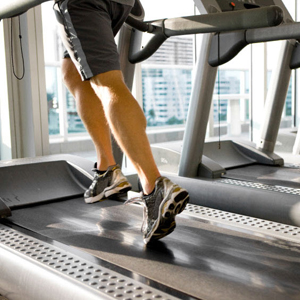
The 2-Minute Treadmill Workout
August 10, 2014 // Nutrition
As the fitness industry has shifted its recommendations from long duration, aerobic cardio to short, interval-based activities, there lies a lot of confusion and hesitance in this new type of exercise. One of the best aspects of interval-based training is the quickness of the workout(s). Gone are the days of 1,000’s of repetitions and revolutions to strengthen your cardio. If you really want to improve all of your fitness levels, all you need is two minutes.
Time vs. Intensity
One of the basic rules for exercise to be effective is that it has to last a specific amount of time. This type of thinking shifts the focus from the intensity of the exercise to the duration. While exercise duration certainly has value, the fastest way to improve your conditioning is to turn up the intensity.
When you increase the intensity of an exercise, you are essentially increasing the amount of effort you will have to exert to perform the exercise. When effort levels rise, different internal systems become taxed. High Intensity exercises produce adaptations within the cardiovascular, respiratory, nervous, endocrine, and muscular systems. High Intensity exercises are the best bang for your buck, hands down.
What Can I Use For High-Intensity?
You can turn any movement/activity into a high intensity exercise if there is a sufficient challenge. [Remember, the “challenge” is person-specific; it should be a demand that is slightly higher than your comfort zone.] If you like kettlebells, there are hundreds of different movements to choose from. If you prefer more open-movement, like running, the treadmill is always a great option.
Recently, I have grown to love sprints and started introducing them weekly at the tail-end of my workouts. It’s an amazing experience when you get to go full-throttle in movement and not have to worry about hurting yourself. Sprinting is such a primitive example of true fitness ability; the speed varies from person-to-person but the effort is 100% across the board.
However, sprinting on a treadmill has its limitations. Treadmill sprints requires a specific, controlled set-up and execution. Also, you are essentially moving at the pace of the treadmill, instead of creating your speed from actually running outside. Sprints are great, but this is even better…
Introducing…
Treadmill Pushes
These are not my creation; I did learn of these beauties from other expert fitness professionals.
Treadmill Pushes are a unique exercise. It’s really clear cut, which means less thinking and more doing on your part. Here’s how it works:
-
Walk onto a treadmill that is OFF
-
Grab the center handles and brace your torso into a forward lean
-
Maintaining your lean, start to move the treadmill belt by extending your legs behind you through the balls of your feet
-
Once the belt starts moving, use your feet to paw at the belt to sustain its momentum
-
Do this as fast as you can to speed up the belt
-
Breathe, obviously, and jump off on the side rails once you reach your intended time
How To Determine Your Time
There are so many work:rest time ratios that exist for different goals. I personally love the simple idea of two minutes of intervals. This gives you incentive to work at 100% effort since you know it’ll be over within 180 seconds. It also gives you the freedom of choosing your work:rest ratios.
My favorites are:
10 seconds of work: 10 seconds of rest – 6 sets
15 seconds of work: 15 seconds of rest – 4 sets
20 seconds of work: 20 seconds of rest – 3 sets
Best Time To Do Treadmill Pushes
Because of the demand of the exercise, I recommend performing Treadmill Pushes at the end of your workout, with the intention to work with full effort until you reach exhaustion. If you want to focus on improving your running at the beginning of your workout with low rest.
Try these out and tell me what you think!
